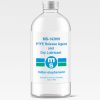No products in the cart.
RA/IPA DryFilm Dispersion | Chemours™ Coating
Chemours™ RA/IPA DryFilm Dispersion are extremely stable PTFE dispersions which provide unmatched lubricity, anti-stick, anti-fouling and mold release properties in an ultra thin-film coating. Used extensively as release agents in processes involving the molding of rubber, plastic, and urethane parts, Chemours™ DryFilm dispersions have a low coefficient of friction that also translates into superior effectiveness as a dry lubricant. This dispersion can also be added to paint and coating formulations to provide added anti-stain, anti-fouling, and high slip properties.
This product is already in your quote request list.
Category: PTFE Bulk Liquid (MS-143)
Tags: Chemours RA/IPA, Dryfilm, ptfe, RA, RA/IPA
CLICK HERE TO CHAT WITH AN EXPERT ABOUT THIS PRODUCTRA/IPA DryFilm Dispersion
Chemours PTFE (Teflon)™ Reliability, Exceptional Lubricity, Superior Anti-Stick and Anti-fouling Properties
Chemours™ RA/IPA DryFilm dispersion are extremely stable lubricants, appropriate for antistick, dry film lubrication and mold release applications. Used extensively as release agents in processes involving the molding of rubber and plastic parts, Chemours™ DryFilm dispersions have a low coefficient of friction that also translates into superior effectiveness as a dry lubricant. In addition, the RA/IPA DryFilm dispersions can be added to liquids and semisolid formulations to enhance lubricity, promote thickening, and retard fouling. Benefits include:
- Ultra-low coefficient of friction
- Superior effectiveness as a dry lubricant
- Retard of fouling in coatings and surfaces
- 100% chemically inert and compatible with nearly all molding substrates
RA/IPA DryFilm Dispersion – Release Agent Applications
Chemours™ RA/IPA DryFilm dispersions are used extensively as release agents in processes involving the molding of rubber and plastic parts. The extreme stability of the RA PTFE resin dispersion means that it is virtually unaffected either by the mold itself or by the material being molded. In commercial applications, air-dried coatings of DryFilm dispersions typically provide multiple releases between applications, even with difficult-to-release materials such as epoxy resins. When DryFilm dispersions are fused onto the mold, they provide added durability and release properties. DryFilm dispersions are superior mold-release agents for a range of industrial applications and substances, offering substantially longer mold-release performance than either oils or silicones.
Sample applications include:
- Molded rubber and plastics
- Chutes and slides
- Plastic laminates
- Conveyor belts
- Laminated wood
- Paper, pressure-sensitive labels
- Resin releasing
- Tanks and bins
RA/IPA DryFilm Dispersion – Dry Lubricant Applications
The low coefficient of friction that is characteristic of Chemours™ RA /IPA DryFilm dispersion translates to superior effectiveness as a dry lubricant. DryFilm dispersions are the lubricant of choice for electric switches, window hardware, military equipment, and a range of other applications for which smooth, repeated movement is essential. PTFE coatings improve abrasion resistance, extending the wear life of the product. They also provide dry lubrication as an inclusion in plastic and metallic bearing applications. PTFE coatings can be infused into electroless nickel-coated components to improve corrosion resistance while providing lubrication. When applied to solid surfaces, DryFilm dispersions produce extremely low static coefficients of friction, the source of their effectiveness as lubricants. Unlike conventional lubricants, DryFilm dispersions minimize “slick-slip” problems. PTFE dispersions are most effective in applications requiring low speeds and light loads. Under some conditions requiring high speeds and high loads, RA/IPA DryFilm dispersion may be abraded from the surface, making reapplication necessary. Adhesion can be improved by adding a binder to the dispersion or by heat-curing.
Sample applications include:
- Lubrication of leather, plastics, and elastomers for use in drive
belts, gaskets, packings, gears, bearings and sleeves, and
chain drives. - Coating and manufacture of metal, fabrics, thread, cord,
twine, rope, and cable made from both natural and
synthetic fibers. - Manufacture of machine parts and fittings, including nuts
and bolts, linkage and connectors, locks, power saw blades,
machine mechanisms, electrical equipment, instruments, and
office machines. - Metalworking operations, including extrusion, rolling, drawing,
and sizing.
RA/IPA DryFilm Dispersion – Additive Applications
Chemours™ DryFilm dispersions can be added to liquid and semisolid formulations to enhance lubricity, promote thickening, and retard fouling. Additional additives can be included with DryFilm dispersion formulations to enhance stability and adhesion. Products such as Chemours™ Zonyl® fluorosurfactants promote stability along with adhesion. As an additive, DryFilm dispersions are used in:
- Paints and finishes, paper and carbon paper coatings, and
printing and writing inks. - Elastomeric and resinous compounds, abrasive and grinding
wheel compositions, and electrical (carbon) brushes. - Waxes and polishes for metals, automobiles, appliances,
furniture, shoes and leather, and for skis, bicycles,
rollerblades, and other sporting equipment. - Bonded solid-film lubricants.
Superior Release Coatings & Unmatched Customer Service – A potent combination which benefits our customers
For any assistance with proper application, storage, or general technical assistance please see the links below or call our technical service line. Miller-Stephenson has a team of molding release experts ready to help you. Our pedigree in the molding industry and relationship with molding operations both large and small provides our technical team with a dynamic perspective, and we hold the skills and experience needed to make sure your molding operation is cost-effective, efficient, and most importantly, safe.
50+ years of Industry Expertise at your service
Miller-Stephenson has had a long history in numerous molding industries, and our Technical Expertise are respected around the world for quality and reliability. When you purchase Miller-Stephenson RA/IPA DryFilm Dispersion products you not only get industry leading service, you also gain access to our many years of direct production floor experience. We understand your production issues and can help you optimize your mold preparation, maintenance and release processes to improve your bottom line.
Click here for information, Which mold release agent is right for you
Notwithstanding any express or implied indication to the contrary, product information provided on or via this website is supplied upon the condition that the persons receiving such information will make their own, independent determination as to a given product’s suitability for any contemplated purposes prior to use. In no event will Miller-Stephenson be responsible for damages of any nature whatsoever resulting from the use of, or reliance upon, information provided, directly or indirectly, on this website in relation to any product and/or application.



